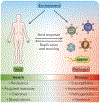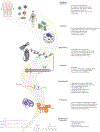A systems approach to infectious disease
- PMID: 32060427
- PMCID: PMC7839161
- DOI: 10.1038/s41576-020-0212-5
A systems approach to infectious disease
Abstract
Ongoing social, political and ecological changes in the 21st century have placed more people at risk of life-threatening acute and chronic infections than ever before. The development of new diagnostic, prophylactic, therapeutic and curative strategies is critical to address this burden but is predicated on a detailed understanding of the immensely complex relationship between pathogens and their hosts. Traditional, reductionist approaches to investigate this dynamic often lack the scale and/or scope to faithfully model the dual and co-dependent nature of this relationship, limiting the success of translational efforts. With recent advances in large-scale, quantitative omics methods as well as in integrative analytical strategies, systems biology approaches for the study of infectious disease are quickly forming a new paradigm for how we understand and model host-pathogen relationships for translational applications. Here, we delineate a framework for a systems biology approach to infectious disease in three parts: discovery - the design, collection and analysis of omics data; representation - the iterative modelling, integration and visualization of complex data sets; and application - the interpretation and hypothesis-based inquiry towards translational outcomes.
Conflict of interest statement
Competing interests
The authors declare no competing interests.
Figures




References
-
- (WHO, W. H. O.) Global Health Estimates 2016: Disease burden by Cause, Age, Sex, by Country and by Region, 2000–2016. (2018).

